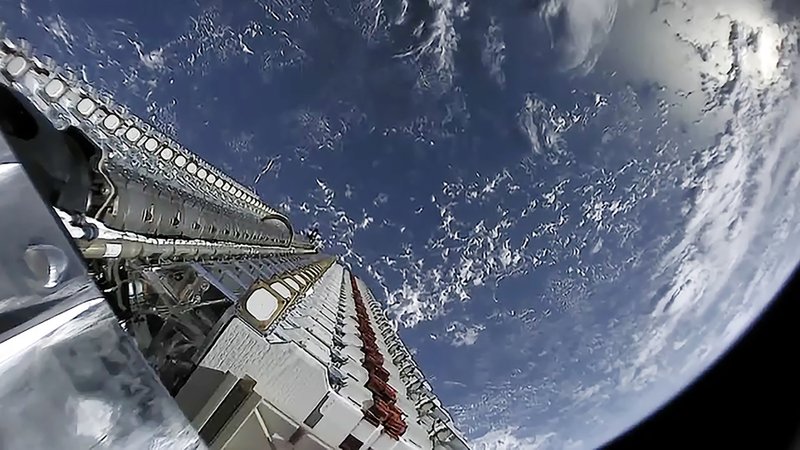SpaceX successfully launched 60 500-pound satellites into space in May. Amateur skywatchers started sharing images of those satellites in night skies, igniting an uproar among astronomers who fear that the planned orbiting cluster will wreak havoc on scientific research and trash our view of the cosmos.
The main concern is that those 60 satellites are merely a drop in the bucket. SpaceX anticipates launching thousands of satellites — creating a mega-constellation of false stars collectively called Starlink that will connect the entire planet to the Internet, and introduce a new line of business for the private spaceflight company.
While astronomers agree that global Internet service is a worthy goal, the satellites are bright — too bright.
"This has the potential to change what a natural sky looks like," said Tyler Nordgren, an astronomer who is now working full time to promote night skies.
And SpaceX is not alone. Other companies, such as Amazon, Telesat and OneWeb, want to get into the space Internet business. Their ambitions to make satellites nearly as plentiful as cellphone towers highlight conflicting debates as old as the Space Age about the proper use of the final frontier.
While private companies see major business opportunities in low-Earth orbit and beyond, skygazers fear space will no longer be "the province of all mankind," as stated in the Outer Space Treaty of 1967.
STARLINK
The Starlink launch was one of SpaceX's most ambitious missions to orbit. Each of the satellites carries a solar panel that not only gathers sunlight but also reflects it back to Earth. Elon Musk, SpaceX's founder and chief executive, has offered assurances that the satellites will only be visible in the hours after sunset and before sunrise, and then just barely.
But the early images led many scientists to question his assertions.
The first captured images, for example, revealed a train of spacecraft as bright as Polaris, the North Star. And while a press officer at SpaceX said the satellites will grow fainter as they move to higher orbits, some astronomers estimate that they will be visible to the naked eye throughout summer nights.
The satellites can even "flare," briefly boosting their brightness to rival that of Sirius, the brightest star in the sky, when their solar panels are oriented just right.
Astronomers fear that these reflections will threaten stargazing and their research.
Whenever a satellite passes through a long-exposure picture of the sky, it causes a long bright streak — typically ruining the image so astronomers must take another one. While telescope operators have dealt with these headaches for years, Starlink alone could triple the number of satellites in orbit, with the number growing larger if other companies get to space.
One estimate suggests that the Large Synoptic Survey Telescope — an 8.4-meter telescope under construction on a Chilean mountaintop that will soon scan the entire sky — might have to deal with one Starlink satellite in every couple of images it takes during the first few hours of twilight.
INTERFERENCE
Astronomers don't yet know how they will adjust. "We're really at that point where we have to assess what we're going to do," said Ronald Drimmel, an astronomer at the Turin Astrophysical Observatory in Italy.
Not only do these satellites reflect light, they also emit radio frequencies -- which a number of astronomers find troubling. Dishes used in radio astronomy are often built in remote locations far from cell towers and radio stations. But if Starlink is launched in full -- with the ability to beam reception toward any place on the planet -- those so-called radio quiet zones could become a thing of the past.
Moreover, some are worried that Starlink plans to operate on two frequency ranges that astronomers use to map the gas throughout the universe — allowing them to see how planets as large as Jupiter assemble, and how galaxies formed immediately after the Big Bang.
"If those frequency channels become inaccessible, it's extremely limiting to what we can learn about the early universe," said Caitlin Casey, an astronomer at the University of Texas at Austin.
Similar concerns emerged in the 1990s when Iridium launched dozens of satellites — which made their own flashes in night skies — to provide global satellite phone coverage. The Iridium constellation's impact was ultimately minimal as technologies changed, and because it never grew larger than 66 satellites. The most reflective of its satellites are gradually falling from orbit.
The National Radio Astronomy Observatory, a federally funded research center that operates facilities across the world, said May 31 in a statement that it has been working directly with SpaceX to minimize potential concerns. The group is discussing what it called exclusion zones around some radio astronomy facilities, where SpaceX's satellites would power down when traveling overhead.
Already, Musk has asked SpaceX to work on lowering future satellites' brightness. And a press officer at Amazon said that it will be years before Project Kuiper — the company's plan to place more than 3,000 Internet satellites into orbit — is available. But Amazon will assess space safety and concerns about light pollution as they design their satellites, the press officer said.
Another entrant, Telesat, said its smaller constellation would operate at higher orbits than some companies' satellites, making their satellites fainter.
"What I find astounding is that whatever we do will affect everyone on the planet," Drimmel said.
Style on 06/10/2019
